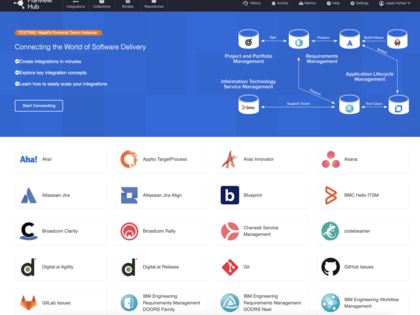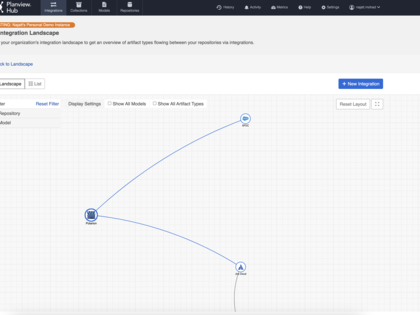Planview Hub (formerly Tasktop Hub) connects the network of best-of-breed tools for planning, building, and delivering software at an enterprise level.
The backbone for the largest and most impactful Agile and DevOps transformations at organizations across the globe, the technology enables organizations to define their software delivery value stream and enables end-to-end visibility, traceability, and governance over the whole process. With the ability to support hundreds of projects, tens of thousands of users, and millions of artifacts, Planview Hub is an easy-to-use, scalable, and reliable integration infrastructure that automates the flow of product-critical information (business value) across tools to optimize productivity, collaboration, and adaptability in an unpredictable and fast-paced digital world. For the first time, enterprises have complete control over one of their most complex, and important, business initiatives.
Product Features
- A world-first model-based paradigm for visually connecting Polarion ALM/QA/Requirements to dozens of tools across hundreds of projects without requiring any coding. For example, user stories, defects, and requirements models are defined in Planview Hub and then can be easily mapped across dozens of different projects and tools.
- Support for applying different styles of integration across tools. For example, Agile and ITSM tools can be integrated for defect/ticket unification and then easily connected to a database for instant Mean Time to Resolution (MTTR) metrics.
- Easy scaling across hundreds of projects. By defining models that span projects and tools, new projects can be on-boarded easily and connected to the value stream.
- All integrations work all of the time thanks to Planview Hub’s unique Integration Factory. For example, multiple versions of the same tool can be connected, along with old versions of legacy tools and the frequently updated APIs of SaaS tools, without breaking because Planview Hub tests all version combinations. Planview Hub supports 60+ tools and hundreds of versions. See the complete list here.
- 'Landscape View' - simple yet dynamic visual overview of an enterprise’s entire software delivery value stream. This first-of-its-kind feature allows users to quickly see which systems are integrated, what models are being flowed, whether flows are one-way or two-way, and which artifacts are flowing, while CIOs have a holistic overview of the value stream to make business-critical decisions faster.
Key unique benefits include:
- Automates the flow of information across the value stream
Enables the frictionless flow of artifacts (such as requirements, defects, user stories, and trouble tickets), as well as information from events (such as build failures, version control changesets, security scan vulnerabilities, and performance monitoring alerts), across the tools and stakeholders in the software development value stream. This removes non-value-added work and bottlenecks; increases velocity and capacity; enhances collaboration; enables automated traceability and even improves employee satisfaction.
- Enables visibility into the value stream
When managers want to see metrics and dashboards to understand project status, optimize the process, or ensure compliance, it has been nearly impossible to get a real-time, holistic view across unintegrated tools. Planview Hub unlocks lifecycle data from these application tool silos by automatically compiling lifecycle activity data into a single database. This data can be used to create consolidated, full-lifecycle reports and dashboards, as well as for traceability reporting.
- Creates a modular, Agile toolchain
Software innovators require a best-of-breed tool strategy. Planview Hub enables organizations to use the products that best support each discipline while getting the benefits of a single, integrated toolchain. Drives more value from each tool; allows organizations to easily add, replace, and upgrade them, creating a proactive environment for innovation.
Planview Hub Overview: Reimagine Integration
Planview Hub Demo: Integrating IBM DOORS Next and Polarion ALM
Planview Hub Demo: Polarion, Atlassian Jira, Micro Focus ALM
Supported Tools
- Aha!
- Ansible
- Ant
- Apptio Targetprocess
- Aras Innovator
- Asana
- Atlassian Bamboo
- Atlassian Jira Core
- Atlassian Jira Software
- Atlassian Jira Service Management
- Automic Release Automation
- BitBucket
- Blueprint and Storyteller
- BMC APM
- BMC Helix ITSM (formerly Remedy)
- BMC Remedy
- Borland Star Team
- Broadcom Clarity
- Broadcom Clarity Agile/Requirements
- Broadcom Rally
- Bugzilla
- CA Release Automation
- Cherwell Service Management
- Cisco AppDynamics
- Clarity PPM
- CloudBees Flow
- codebeamer
- Compuware APM
- Conformiq
- Coverity
- Cucumber
- CVS
- Digital.ai Agility
- Digital.ai Release
- Dynatrace
- Gerrit
- Git
- GitHub Issues
- GitLab Issues
- Grunt
- Hudson
- Chef
- IBM APM
- IBM Engineering Requirements Management DOORS Family
- IBM Engineering Requirements Management DOORS Next (DNG)
- IBM Engineering Workflow Management
- IBM Rational ClearQuest
- IBM Requisite Pro
- IBM RQM
- IBM RTC
- IBM Security AppScan
- IBM UrbanCode Release
- IBM UrbanCode uBuild
- IBM UrbanCode uDeploy
- iRise
- Jama Connect
- Jenkins
- JetBrains TeamCity
- Jira Core
- Jira Service Desk
- Maven
- Micro Focus ALM Octane
- Micro Focus ALM/Quality Center
- Micro Focus Dimensions RM
- Micro Focus Fortify
- Micro Focus PPM
- Micro Focus Solutions Business Manager
- Micro Focus UFT
- Microsoft Azure DevOps Server (formerly TFS)
- Microsoft Azure DevOps Services (formerly VSTS)
- Microsoft Project Server
- Microsoft SharePoint
- Microsoft Test Manager
- Modern Requirements4DevOps
- Mozzila Bugzilla
- New Relic
- OpenMake
- Perforce
- Pivotal Tracker
- Planview AdaptiveWork (formerly Clarizen)
- Planview AgilePlace (formerly LeanKit)
- Planview Enterprise Architecture
- Planview Portfolios (formerly Enterprise One)
- Planview PPM Pro
- Planview Universal Connector
- Polarion ALM
- PTC Windchill
- PTC Windchill RV&S
- Puppet
- Rally (formerly CA Agile Central)
- Salesforce: Sales Cloud, Service Cloud, Marketing Cloud
- Salt
- Selenium
- Serena Release Control
- ServiceNow: IT Service Management
- ServiceNow: IT Business Management (Agile Development/SDLC, PPM)
- ServiceNow Express
- Siemens Polarion
- SmartBear QAComplete
- SonarQube
- Sparx Systems EA
- Sparx Systems Pro Cloud Server
- Stash
- Subversion (SVN)
- TestRail
- Thoughtworks Go
- Thoughtworks Mingle
- Travis-CI
- Trello
- Tricentis qTest
- Tricentis Tosca
- Trello
- UiPath Test Manager
- Vagrant
- Veracode
- VersionOne
- WhiteHat Sentinel
- Windows Powershell
- XebiaLabs XL Release
- Xray Test Management for Jira
- Zendesk
- Zephyr Squad for Jira
You can find the full documentation here.


